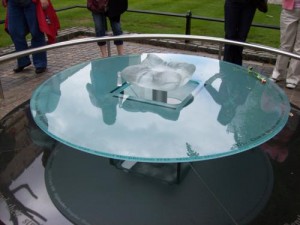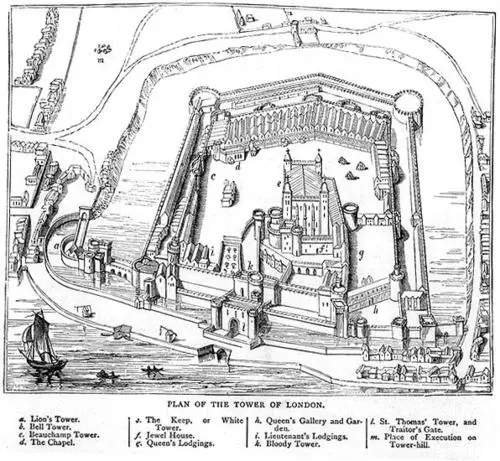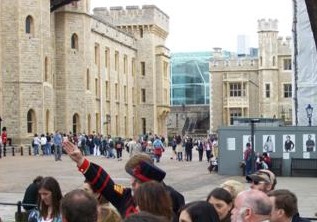
I though I’d write a post on the site of Anne Boleyn’s execution because I get lots of emails asking me about it. Many people think that the present day glass memorial on Tower Green marks the scaffold site and it is a shame that people are misled in this way and that they leave the Tower of London without standing on the true spot. Anne Boleyn fans want to stand on the spot and pause a while (well, I do anyway!) and many end up standing in the wrong place.
The Tower Green Memorial
During the winter and spring of 1876 and 1877 restoration work was carried out on the Chapel of St Peter ad Vincula, the Tower of London chapel. You can read more about this restoration work and the findings of the Victorian team in my article “Anne Boleyn’s Body Found?”, but it was also at this time that it was decided to erect a memorial tablet, listing those who were buried in the chapel, on the wall near the entrance door, and a few years earlier a memorial plaque had been placed on a railed off area of Tower Green to in memory of those who had met their deaths there.
On 4th September 2006, a new memorial was unveiled on Tower Green. This new memorial, the one visitors see today, was designed by British artist Brian Catling and aimed to provide visitors with a focal point for remembrance and reflection. It features two engraved glass circles, listing those executed on Tower Green, with a sculpted glass pillow as the focal point in the centre. On the polished black stone base is the following poem:-
“Gentle visitor pause a while,
Where you stand death cut away the light of many days.
Here, jewelled names were broken from the vivid thread of life.
May they rest in peace while we walk the generations around their strife and courage,
Under these restless skies.”
Brian Catling explained, “I wanted to make people walk around the piece. Before, people would come and stand in front of the small plaque that used to be here – they just stood and didn’t know what to do so I thought: ‘let’s give them something to do’, they now have to walk around it to read the poem – they have to engage with it” and I do think it is a more fitting memorial than a simple plaque, which is easy to miss, and on the 19th May, the anniversary of Anne Boleyn’s execution, people leave flowers on it as well as in the Chapel. However, the memorial does not mark the site of the scaffold used for Anne Boleyn, Catherine Howard and Lady Jane Grey, and neither does it mark the site of the scaffold used for the likes of Thomas More, Thomas Cromwell and George Boleyn, that site is on Tower Hill and is marked by plaques listing the names of those executed there.

The True Scaffold Site
What we have to remember is that the Tower of London in 1536 was very different to the present day Tower. In 1536 the building known today as the Queen’s House did not exist (Note: This was not where Anne Boleyn was imprisoned as this building was not built until around 1540. Anne was imprisoned in the Queen’s Lodgings – marked “g” on the above plan – of the Royal Palace which is no longer standing.) and neither did the Waterloo Block (formerly the Waterloo Barracks), the building which houses the Crown Jewels, which was built in the mid 19th century. If you look on the 1597 plan of the Tower, you can see that Tower Green used to stretch right round from the chapel (marked “d”) to the north of the White Tower (marked “e”) and it is on the present day gravelled parade ground between the White Tower and the Waterloo Block that Anne Boleyn met her death.1
So, if you want to pay your respects at the real site of Anne Boleyn’s execution, where should you stand?
Well, if you take a look at the Tower of London plan at http://www.hrp.org.uk/Resources/Tower%20of%20London.pdf, you will notice that there is a red circle near to the number 40 which is labelled “Entrance to the Crown Jewels”. That’s where you need to go. Stand between the White Tower and the entrance to the Waterloo Block/Crown Jewels and you will be standing where Anne Boleyn was executed. If you look on the above photo, which was taken from the present day glass memorial, you can see the Waterloo Block on the left and the White Tower (with barriers and scaffold around it) on the right and people walking between the two – the people are walking where the scaffold site was located, just above the Yeoman Warder’s hat!
Here is a video I did about the locations of Anne Boleyn’s prison and execution spot:
Notes
- We know from primary sources that carpenters worked through the night of the 17th building a new scaffold “before the House of Ordnance”. Lisle Letters, Volume 3, 698, John Husee to Lord Lisle, 19 May 1536: “And Anne the late Queen suffered with sword this day, within the Tower, upon a new scaffold;”; Ives, Eric (2004) The Life and Death of Anne Boleyn, p. 423, note 1: “She was beheaded on a new scaffold ‘before the house of Ordnance’, i.e. on what is now the parade ground north of the White Tower”, citing “Antony Antony in Herbert, Henry VIII (1679), facing p.385.”
Sources
- Tower Of London Unveils Memorial To The Executed
- “Notices of the Historic Persons Buried in the Chapel of St Peter ad Vincula in the Tower of London” by Doyne C Bell (1877)
- Ives, Eric (2004) The Life and Death of Anne Boleyn, Wiley Blackwell.
- Lisle Letters, Volume 3.
